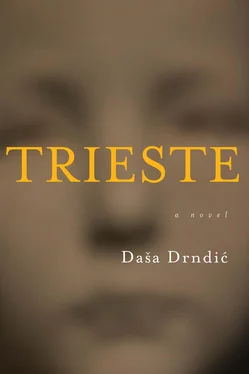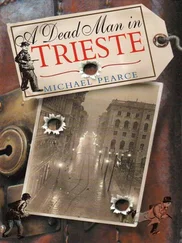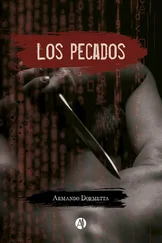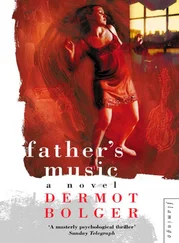At the doll and toy exhibition Haya and Jarmušek look at a photograph beneath which there is a pile of old toys, stained and broken. The picture shows first-grade Nuremberg pupils from the Jewish elementary school located at the time at Obere Kanalstrasse 25. The picture is dated 1936. Each child in the picture is holding a toy. The boys hold a paper cone of some sort in which there might be sweets, models of little metal automobiles in lively colours, perhaps a small train, a tin soldier or a miniature tank. Most of the girls are holding dolls.

But by 1943, when Hitler puts a stop to toy manufacturing, the children in the picture no longer exist. Four of them (numbers 10, 18, 32 and 33) are deported to Poland with their families in 1942, to Izbica, the packed departure lounge for Belsen. Their teacher is taken to Krasniczyn. No-one knows who the children marked 2, 8, 9, 12, 14, 15, 16, 19, 24, 28, 30, 31, 35 and 36 are, where they have gone or what has happened to them. Perhaps they are riding along on a moveable shelf in Bad Arolsen, which Haya knows nothing about at that point, though she might have known. But no matter where the children from the picture went, no matter where they were taken, in 1942 they probably carried a toy with them. They were the children of Nuremberg, connoisseurs when it came to dolls, trains and automobiles.
When Birkenau was liberated, aside from the gold teeth, the hair and clothing, the piles of bones, dolls were also found, many of them from Nuremberg. Their hair pulled out, naked, with no limbs, often with eyes missing, so similar to their little owners. In camps, objects and people merge. In camps, objects and people become symbiotic.
These camp dolls are like Bellmer’s, but smaller, Jarmušek says.
Bellmer who? asks Haya.
Three years before the picture of the first-graders of the Jewish elementary school was taken in Nuremberg, in Berlin Hans Bellmer fashions his first life-size doll, as if mocking the future Borghild. Afterwards, Bellmer makes many more “sick” Puppen in Paris. He makes Puppen with moveable pubic bones, with mobile, twisted limbs, with extra limbs; Puppen with feet in white socks and children’s shoes, their private parts without pubic hair; gigantic monstrosities of immature adults who mock the impeccably modelled, muscular bodies which Leni loves photographing and Adolf loved watching. Bellmer’s Puppen were monster Puppen, huge mirrors reflecting history and its Macher .
Albrecht Dürer was born in Nuremberg, Jarmušek says.
And Hans Sachs, Haya says.
The first pocket watch was made in Nuremberg, Jarmušek says.
The first European railway line was built in Nuremberg, Haya says.
The Nuremberg laws were adopted in Nuremberg.
There were trials in Nuremberg.
Nuremberg was reduced to rubble by bombs. Nuremberg was a rubbish dump with 100,000 people left homeless.
Nuremberg has a promenade along the River Pegnitz. Let’s go for a walk along the Pegnitz, Haya says. Are there any Jews in Nuremberg?
We learned a lot about Nuremberg, Jarmušek says.
Yes. Nuremberg is a green city, Haya says.
Later, Haya left, Jarmušek flew away. Like a blonde angel Jarmušek flew over Berlin, and Haya went back to Gorizia. I cannot fly with you, she said. I cannot.
Do birds chirp in flight? Haya asks a woman who is sitting next to her. The woman who is sitting next to Haya is elderly, about seventy, and she appears to be agitated.
It is a crime to catch song birds and cage them, says the lady sitting next to Haya. That’s what my neighbour does. My neighbour has nine caged birds, which no longer sing, she says.
We started out down Himmelweg.
To paradise?
To the chirping of birds.
What is your name?
Rajzman, Samuel Rajzman.
What did you do before the war?
Before the war I was an accountant at an export firm.
When did you turn up at Treblinka and how did you get there?
In August 1942 they picked me up in the Warsaw Ghetto.
How long were you at Treblinka?
For a year. Until August 1943.
Describe the Treblinka camp.
Trains arrived every day, sometimes three, sometimes four, sometimes five of them. All the travellers were Jews. Jews from Czechoslovakia, from Germany, from Greece and Poland. As soon as the trains stopped, the people had to disembark at once, within five minutes. On the platform they were sorted into groups, men in one group, women in another, children in a third. Then they ordered them to take off their clothes. While the people hurried to strip off their clothing, the German guards snapped their whips. Then the old camp inmates would come. They would collect the clothing and take it to the barracks. The people walked naked along a special path to the gas chambers.
What did the Germans call the path?
Himmelfahrtstrasse.
The Street of the Heavenly Path? The Road to Heaven?
Something along those lines. I can draw you where the path went.
No need. How long did people live after they arrived at Treblinka?
Not long. From when they stripped off their clothes to when they arrived at the gas chamber, at most ten minutes. The men. Fifteen minutes for the women, because first they had to have their hair cut.
Why did they cut the women’s hair?
There was talk that they were using the hair to make mattresses for German women.
I cut women’s hair.
You are?
Abraham Bomba. I was a barber before the war. At Treblinka I cut mens and women’s hair, mostly women’s. After the war I opened a hair salon in the basement of New York Grand Central Station.
Where did you cut the women’s hair?
First in the gas-chamber, before they gassed them, later in the undressing barracks. When they stripped them naked the women were first examined, then sent to us for a haircut. The women were always naked when we cut their hair.
How were they examined, by whom?
They were laid on tables and their intimate parts were examined. Those were not professionals, not doctors. They were supposed to find out if the women hid any valuables, gold, money, jewellery, in their vaginas. These men used leather gloves for their examinations, so the women bled terribly.
How many barbers did the work?
I don’t remember precisely. Some were professional barbers, others were not. There was this Jewish Camp Elder, engineer Galewski. He told us what to do.
What did he say?
He said we should make believe we’re giving the women a real haircut, so they wouldn’t know they were going to be gassed, so they would believe that after the haircut they were going to take a shower. He said, don’t make them look like monkeys.
How much time did you have for each haircut?
Two minutes. It was very painful. Some barbers recognized their wives, their mothers, their grandmothers, and they just had to go on cutting. And they weren’t allowed to say a word. Not even hug before their dear ones were to be gassed. It was very hard to watch. It was horrible. It was awfully painful.
Rajzman, describe the railway station at Treblinka.
At first there were no signboards whatsoever at the station, but a few months later Kurt Franz, the camp commander, ordered they be put up. The barracks where the clothing was stored had signs reading “RESTAURANT”. Then there were signs for “TELEPHONE”, “POST OFFICE”, “WAITING ROOM”. There were even train schedules for the departure and arrival of trains from, say, Vienna and Berlin.
Читать дальше













